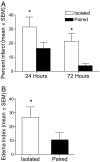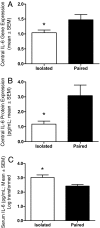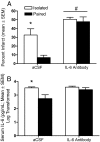Social isolation alters neuroinflammatory response to stroke
- PMID: 19307557
- PMCID: PMC2667090
- DOI: 10.1073/pnas.0810737106
Social isolation alters neuroinflammatory response to stroke
Abstract
Social isolation has dramatic long-term physiological and psychological consequences; however, the mechanisms by which social isolation influences disease outcome are largely unknown. The purpose of the present study was to investigate the effects of social isolation on neuronal damage, neuroinflammation, and functional outcome after focal cerebral ischemia. Male mice were socially isolated (housed individually) or pair housed with an ovariectomized female before induction of stroke, via transient intraluminal middle cerebral artery occlusion (MCAO), or SHAM surgery. In these experiments, peri-ischemic social isolation decreases poststroke survival rate and exacerbates infarct size and edema development. The social influence on ischemic damage is accompanied by an altered neuroinflammatory response; specifically, central interleukin-6 (IL-6) signaling is down-regulated, whereas peripheral IL-6 is up-regulated, in isolated relative to socially housed mice. In addition, intracerebroventricular injection of an IL-6 neutralizing antibody (10 ng) eliminates social housing differences in measures of ischemic outcome. Taken together, these data suggest that central IL-6 is an important mediator of social influences on stroke outcome.
Conflict of interest statement
The authors declare no conflict of interest.
Figures




Similar articles
-
Social interaction modulates the neuroinflammatory response to global cerebral ischemia in male mice.Brain Res. 2017 Oct 15;1673:86-94. doi: 10.1016/j.brainres.2017.08.008. Epub 2017 Aug 12. Brain Res. 2017. PMID: 28807664 Free PMC article.
-
Social interaction improves experimental stroke outcome.Stroke. 2005 Sep;36(9):2006-11. doi: 10.1161/01.STR.0000177538.17687.54. Epub 2005 Aug 11. Stroke. 2005. PMID: 16100018
-
Social isolation initiated post-weaning augments ischemic brain injury by promoting pro-inflammatory responses.Exp Neurol. 2024 May;375:114729. doi: 10.1016/j.expneurol.2024.114729. Epub 2024 Feb 15. Exp Neurol. 2024. PMID: 38365135
-
Social contact influences histological and behavioral outcomes following cerebral ischemia.Exp Neurol. 2009 Dec;220(2):276-82. doi: 10.1016/j.expneurol.2009.08.022. Epub 2009 Sep 3. Exp Neurol. 2009. PMID: 19733169
-
Modeling Transient Focal Ischemic Stroke in Rodents by Intraluminal Filament Method of Middle Cerebral Artery Occlusion.Methods Mol Biol. 2018;1717:101-113. doi: 10.1007/978-1-4939-7526-6_9. Methods Mol Biol. 2018. PMID: 29468587 Review.
Cited by
-
AQP4 knockout aggravates ischemia/reperfusion injury in mice.CNS Neurosci Ther. 2012 May;18(5):388-94. doi: 10.1111/j.1755-5949.2012.00308.x. CNS Neurosci Ther. 2012. PMID: 22533723 Free PMC article.
-
Maternal inhibition of infant behavioral response following isolation in novel surroundings and inflammatory challenge.Dev Psychobiol. 2013 May;55(4):395-403. doi: 10.1002/dev.21044. Epub 2012 May 9. Dev Psychobiol. 2013. PMID: 22573346 Free PMC article.
-
Neuronal Mechanisms that Drive Organismal Aging Through the Lens of Perception.Annu Rev Physiol. 2020 Feb 10;82:227-249. doi: 10.1146/annurev-physiol-021119-034440. Epub 2019 Oct 21. Annu Rev Physiol. 2020. PMID: 31635526 Free PMC article. Review.
-
Dim light at night impairs recovery from global cerebral ischemia.Exp Neurol. 2019 Jul;317:100-109. doi: 10.1016/j.expneurol.2019.02.008. Epub 2019 Feb 26. Exp Neurol. 2019. PMID: 30822422 Free PMC article.
-
Role of social factors on cell death, cerebral plasticity and recovery after stroke.Metab Brain Dis. 2015 Apr;30(2):497-506. doi: 10.1007/s11011-014-9544-1. Epub 2014 Apr 22. Metab Brain Dis. 2015. PMID: 24748365 Free PMC article. Review.
References
-
- Boden-Albala B, Litwak E, Elkind MS, Rundek T, Sacco RL. Social isolation and outcomes post stroke. Neurology. 2005;64:1888–1892. - PubMed
-
- Lett HS, et al. Social support and prognosis in patients at increased psychosocial risk recovering from myocardial infarction. Health Psychol. 2007;26:418–427. - PubMed
-
- Barry LC, Kasl SV, Lichtman J, Vaccarino V, Krumholz HM. Social support and change in health-related quality of life 6 months after coronary artery bypass grafting. J Psychosom Res. 2006;60:185–193. - PubMed
-
- Ikeda A, et al. Social support and stroke and coronary heart disease: The JPHC study cohorts II. Stroke. 2008;39:768–775. - PubMed
-
- Cohen S, Lemay EP. Why would social networks be linked to affect and health practices? Health Psychol. 2007;26:410–417. - PubMed
Publication types
MeSH terms
Substances
Grants and funding
LinkOut - more resources
Full Text Sources
Medical
Molecular Biology Databases

